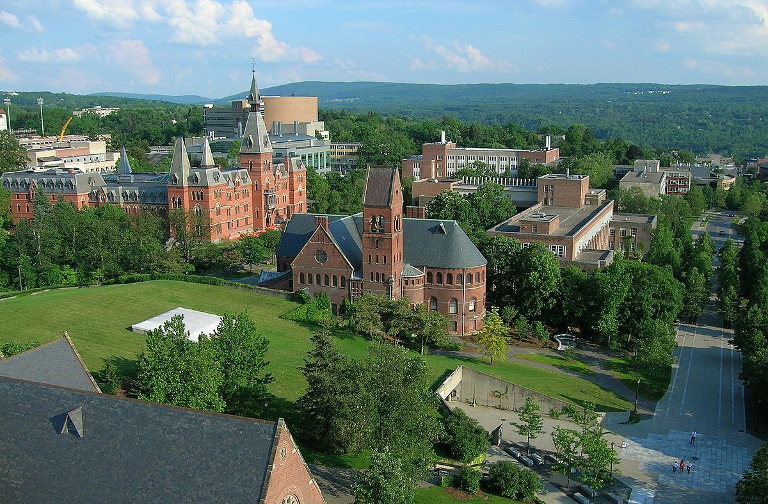The long-predicted impacts of climate change are now a daily reality. Today, we’re seeing record-smashing heat; unprecedented storms; and a “fire season” that burns year-round. And worse is yet to come. The impacts we’ve experienced so far reflect a modest global temperature increase of 1.8 degrees Fahrenheit. But current emissions and accelerated warming trends point to a much hotter, wilder climate in the years ahead.
Like every other institution in our society, colleges and universities are affected by the changing climate. They face new threats to campus infrastructure, and to the safety of students, faculty and staff. But while colleges and universities grapple with these problems, they can also be part of the solution. That’s the conclusion of a pilot project — Climate Resilience in Urban Campuses + Communities (CRUX) — designed to boost the resilience of higher education institutions and the communities they inhabit.
The lessons learned from the project have informed and inspired efforts by a larger group of colleges and universities, which spent the past year assessing their campus and community resilience to climate change. Their efforts have identified several key resilience-building strategies:
Work with the community to assess and address the challenges
A campus is not an island; its risk and resilience is tied to that of its surrounding community. It makes sense, then, to work with community members to assess challenges and brainstorm solutions. Colleges and universities have much to bring to the table, including research and technical capacity, and the stature to convene a diverse group of interested parties.
In some places — such as Fayetteville, Arkansas — universities are starting the conversation about climate resilience. Faculty and students from the University of Arkansas convened community leaders responsible for pieces of the resilience puzzle — including human health, the natural environment, and emergency response — who rarely sat at a table together. Together, they reviewed likely climate impacts, tallied community assets, and developed an action plan to reduce vulnerability.
Elsewhere, the conversation begins with a climate-related crisis. That’s what happened in Aurora, New York, home to Wells College. Despite a history of strained town-gown relations, the college and town came together in the summer of 2017 to deal with harmful algal blooms (HABs) in neighboring Cayuga Lake that threatened their shared drinking water supply. The college and town worked together to explore short-term solutions, and — because HABs are a known climate change impact — this crisis lent urgency to broader resilience planning.
Build community resilience — especially for the most vulnerable
Climate disasters hit marginalized people first and worst. Many colleges and universities have connections to vulnerable communities, through direct service programs or ties to local community organizations. Those connections can be leveraged to build the resilience of those communities, ensure their inclusion in adaptation planning, and provide help in an emergency.
For example, the University of Illinois Chicago is a major provider of health care to underserved communities through its nine health-related colleges, outpatient clinics and hospital. The University is currently devising plans to coordinate emergency preparedness, notification and response through its health care network, in partnership with the Illinois Medical District.
And, as “anchor institutions” in their communities, colleges and universities can lend their facilities to the cause of preparing for — and recovering from — climate impacts. For example, a university can designate a space on campus as a resilience hub, which offers community relationship-building as well as cooling centers and emergency shelters.
Become a resilience innovation lab
Research and innovation are the twin superpowers of higher education institutions — and they can be deployed to address the challenge of climate resilience. Faculty can design curricula on climate impacts and solutions, and support students in research, outreach, and implementation of projects.
Innovation begins with deep understanding of the challenge at hand. That’s why Portland State University partnered with city agencies to develop the online mapping tool. The interactive tool shows the detailed distribution of heat islands, traffic-related air quality, and social vulnerability in the Portland Metro area. This enables community members and planners to see where climate impacts are hitting the community hardest, and where those being affected have the least capacity to respond to and withstand these effects.
Higher education institutions can tap one of their greatest resources, students, to help solve the climate challenge. At California State University, Northridge (CSUN), a class of urban planning graduate students led a resilience assessment for CSUN and the community of Northridge. The project culminated in a for both the campus and community.
Improve campus Infrastructure
Universities can improve the resilience of campus infrastructure, which may also benefit surrounding neighborhoods. And, because universities face many of the same challenges as the larger community, they can model actions and pilot initiatives on a smaller scale.
Many colleges and universities are initiating efforts to conserve energy use and develop responsible storm water management. For example, the University of Illinois Chicago has developed a green infrastructure plan that would re-landscape UIC’s 240-acre downtown campus to capture and retain storm water. This will help keep runoff out of the city’s combined storm water-sewer systems, which contaminate local streams, rivers, and Lake Michigan — Chicago’s drinking water source. Storm water management is especially impactful as climate change triggers more intense precipitation events.
Colleges and universities can also implement smaller infrastructure improvements, which serve as demonstration projects while incrementally increasing campus resilience. For example, Phoenix, Arizona is facing extreme heat. This led South Mountain Community College to prioritize the installation of a new water bottle filling station in one of the hottest locations on campus, to mitigate heat-related illness. Many schools identified visible projects and “easy wins” as important components of a broader strategy to improve resilience.
Address food insecurity
Hunger is a problem for many communities and campuses, and climate change can make the problem worse. Droughts and storms can ruin crops and boost food prices; disasters can sever food supply chains. Colleges and universities can help address food insecurity and promote greater local self-sufficiency by, for example, supporting urban agriculture initiatives and expanding access to food assistance programs.
To help ensure food security among its students, California State University Northridge (CSUN) maintains a food pantry, food garden, fruit trees, and a food system that works to find and help students who are food insecure. CSUN also promotes the use of CalFresh EBT cards (a state food aid program) at campus farmers markets for those who need it. Similarly, Chatham University in Pittsburgh works with the local Food Policy Council to improve access to healthy foods in public schools and low-income communities. And Chatham’s food service sources food from local farms — including one on campus — leveraging its purchasing power to build a vibrant local food movement.
Climate change poses unprecedented challenges to our communities, colleges and universities included. As we work to address these challenges, institutions of higher learning have much to contribute. Through innovation, infrastructure, and our greatest asset — engaged, committed, smart students — we can lead the way to a climate-resilient future.
By sach1tb, CC BY-SA 2.0





